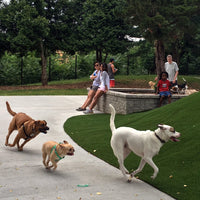OnGuard Training: 3 Steps to Success!
The OnGuard™ is designed to make training your dog easier, as well as to stop unwanted barking and bad behaviors in their tracks! It's one of our most versatile products, but still people ask what its purpose is and how they are supposed to use it effectively. So let's talk about it and find out exactly what this device can do for you!
OnGuard can be used to stop your dog from barking at other dogs on walks, jumping on strangers, play biting, digging, whining, begging, barking at the TV, getting on the furniture, counter surfing, and really any unwanted behavior.
And unlike clicker training where the clicker indicates a reward, the OnGuard is designed to distract and stop a bad behavior the moment it happens.
-
Know Your Dog
Every dog has a different learning style. What do they respond best with? Is he eager to please, super stubborn, or a more timid learner?
Understanding how they learn will help guide you through the training, and will encourage you and your dog to bond through this experience.
-
Understand the Basics
The keys to successful training are consistency, repetition – and of course – tasty treats! They can even be tiny treats, the goal is to find something that's extra delicious smelling – for example, tiny pieces of hot dog will keep your pup's utmost attention.
Before you start a training session, you should go on a walk or play a game of fetch. Just like kids, dogs need to get those wiggles out so that they can focus! It can also be helpful to train when they are hungry, so that they'll be extra receptive to treats.
When you begin training, focus on one command (or trick) at a time so that the dog doesn't get confused.
For example: if you want to train your dog to “sit”, then you should only work on that one behavior until they have fully gotten the “sit” concept down. Then you can move on to the next task.If your dog is not getting the task at hand, it can be frustrating for both of you. Try not to get discouraged, training takes time and patience.
-
Build on a Good Thing
If your dog already knows some basic commands – and you are ready to tackle more complex issues such as chewing, jumping, digging, barking, begging, or other bad habits – the OnGuard will be your new best friend!
When you catch your dog doing something naughty, start with a voice command to get his attention. If that doesn't work (which usually in the first stages of training it won't) then grab your OnGuard, aim the device at your dog, and press the ultrasonic “dog” button. This will be the button on the bottom of the device (under your index finger).
Your dog won't like the strange sound, and should instantly be distracted from their bad behavior. The moment they stop is the best time to offer verbal praise and a treat to reward this new, good behavior. Repeat as needed, and over time he'll learn to stop altogether. Remember that consistency is your key to success!
Please note: the only time we do not recommend OnGuard (or any sound-based training device) is with young puppies, or dogs that might have behavioral issues due to medical problems such as pain or severe anxiety.
If you have any questions about using your OnGuard, our friendly support team is here to help. Just , email us, or give us a call at 1-800-657-8214!




